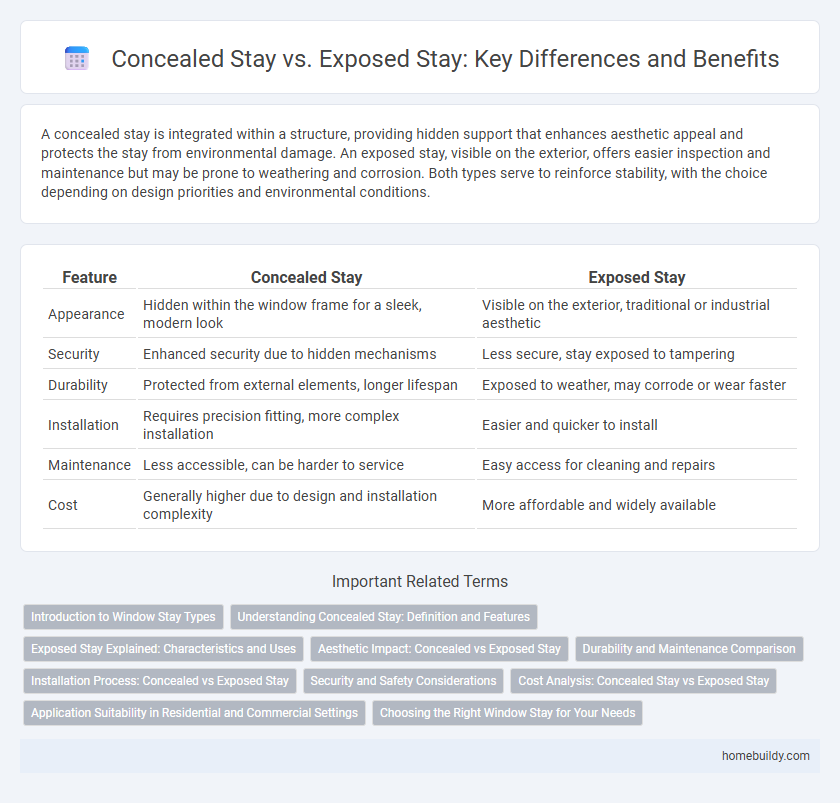A concealed stay is integrated within a structure, providing hidden support that enhances aesthetic appeal and protects the stay from environmental damage. An exposed stay, visible on the exterior, offers easier inspection and maintenance but may be prone to weathering and corrosion. Both types serve to reinforce stability, with the choice depending on design priorities and environmental conditions.
Table of Comparison
| Feature | Concealed Stay | Exposed Stay |
|---|---|---|
| Appearance | Hidden within the window frame for a sleek, modern look | Visible on the exterior, traditional or industrial aesthetic |
| Security | Enhanced security due to hidden mechanisms | Less secure, stay exposed to tampering |
| Durability | Protected from external elements, longer lifespan | Exposed to weather, may corrode or wear faster |
| Installation | Requires precision fitting, more complex installation | Easier and quicker to install |
| Maintenance | Less accessible, can be harder to service | Easy access for cleaning and repairs |
| Cost | Generally higher due to design and installation complexity | More affordable and widely available |
Introduction to Window Stay Types
Window stays are crucial hardware components that control the opening angle and secure the position of windows, with two primary types being concealed and exposed stays. Concealed stays are installed within the window frame, offering a sleek, minimalist appearance and enhanced security by minimizing visible metal parts. Exposed stays, mounted externally on the sash or frame, provide straightforward installation and adjustability, commonly found in traditional or heritage window designs.
Understanding Concealed Stay: Definition and Features
Concealed stays are window hardware components installed within the window frame, hidden from external view to enhance aesthetics and security. These stays provide smooth, controlled opening and closing mechanisms, often featuring friction or multi-position locking options for precise ventilation control. The seamless integration of concealed stays contributes to a sleek window design while maintaining robust functionality and durability.
Exposed Stay Explained: Characteristics and Uses
Exposed stays are window hardware components visible on the interior surface, offering easy installation and maintenance. They provide robust support for windows, allowing precise control over opening angles and enhancing ventilation. Commonly used in residential and commercial buildings, exposed stays are ideal for heavier window sashes due to their durability and straightforward design.
Aesthetic Impact: Concealed vs Exposed Stay
Concealed stays enhance window aesthetics by remaining hidden within the frame, offering a sleek and minimalist appearance that blends seamlessly with modern architectural designs. Exposed stays, while functional and easier to access for maintenance, can disrupt the clean lines of a window, making them more noticeable and less desirable for styles prioritizing visual subtlety. Choosing concealed stays maximizes aesthetic appeal by minimizing visible hardware, ideal for contemporary and high-end window installations.
Durability and Maintenance Comparison
Concealed window stays offer enhanced durability due to their protection from external elements, reducing corrosion and wear over time. In contrast, exposed stays are more susceptible to environmental damage, requiring frequent maintenance and potential replacement. Maintenance for concealed stays is minimal, often limited to occasional lubrication, whereas exposed stays demand regular cleaning and inspection to ensure long-term functionality.
Installation Process: Concealed vs Exposed Stay
Concealed stays require a more intricate installation process involving precise cutting and fitting within the window frame, ensuring the hardware remains hidden for a cleaner aesthetic. Exposed stays are simpler to install, usually mounted directly onto the window sash and frame, allowing for easier maintenance and adjustments. The installation choice affects both the window's appearance and the accessibility of the stay for repairs.
Security and Safety Considerations
Concealed window stays enhance security by hiding locking mechanisms within the frame, making it difficult for intruders to tamper with the hardware. Exposed stays, while easier to maintain and adjust, present visible components that can be targeted to compromise window integrity. Choosing concealed stays significantly improves safety by reducing unauthorized access risks and providing a cleaner, more secure window design.
Cost Analysis: Concealed Stay vs Exposed Stay
Concealed stays generally incur higher costs due to complex installation and material expenses compared to exposed stays, which are more affordable and easier to maintain. The long-term maintenance expenses of concealed stays tend to be lower since they are protected from environmental damage, whereas exposed stays may require frequent repairs or replacements. Cost analysis should balance initial investment against durability and aesthetics to determine the best option for specific window applications.
Application Suitability in Residential and Commercial Settings
Concealed stays offer a sleek, unobtrusive appearance ideal for modern residential windows where aesthetics and security are priorities, blending seamlessly with frames in living rooms and bedrooms. Exposed stays provide robust support and easy maintenance for commercial settings such as offices and retail spaces, accommodating larger windows that require frequent adjustments and enhanced ventilation. The selection between concealed and exposed stays depends on the functional demands and design preferences of residential versus commercial environments.
Choosing the Right Window Stay for Your Needs
Choosing the right window stay depends on balancing aesthetics, security, and functionality. Concealed stays offer a sleek, hidden mechanism that enhances modern window designs while providing sturdy support and improved security. Exposed stays, often easier to install and maintain, suit traditional or industrial styles and allow for quick adjustments and repairs.
Concealed stay vs Exposed stay Infographic

 homebuildy.com
homebuildy.com